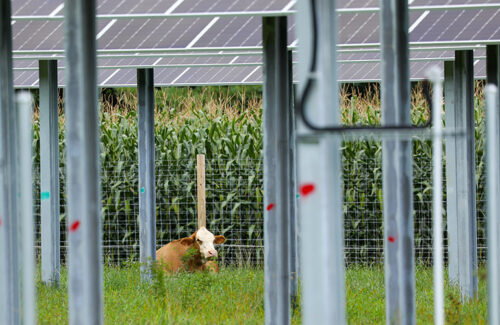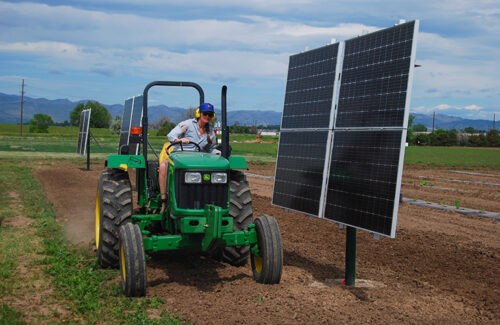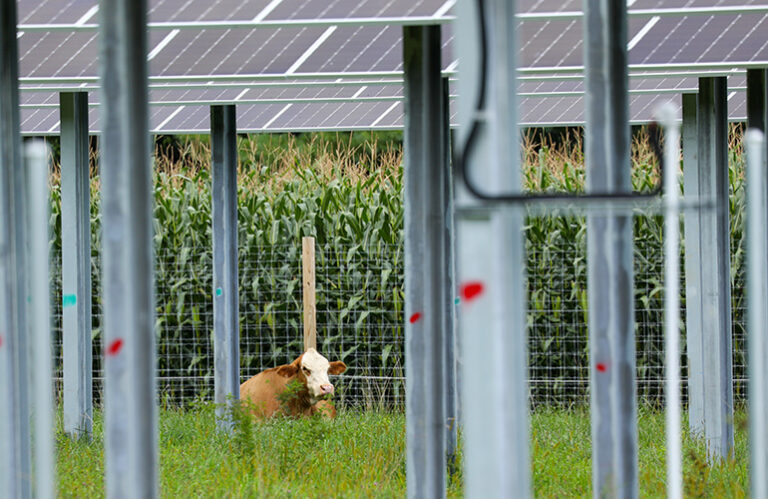The American solar industry tests the viability of co-locking solar PV and agriculture on the same suddenly, and the solar racking that is used in these projects makes that possible.

Credit: Bluewave
Linking solar projects and agriculture is not yet an exact science, but regardless of the activity that happens under or near a PV -Array – if that has a tendency to cultivate or maintain pollers – it often requires Larger stretching and more space between module rows. This combination of solar energy and agriculture is a form of photovoltaic with double use, also known as Agrisolar or Agrivoltaics.
According to the 2022 Census of AgricultureThe United States had more than 1.9 million farms that tend to be up to 880 million hectares of agricultural land. Although this is still good for millions of square miles of land, since 1997 the American agricultural land has decreased by nearly 75 million hectares, according to Census Reporting. The majority of that lost agricultural land is Pastureland that is used for cattle and traces with a policy change so that farmers can grow animals in a detention, According to an analysis published by Farm Docdaily.
“Farmers are very receptive to the idea of Agrivoltaïschens, but hesitant to take projects with risk,” said Ian Skor, owner and CEO of Sandbox SolarA solar contractor in Fort Collins, Colorado, who defends Agrivoltaics. “Small changes in their agricultural practice can have a major impact. They already work on slender margins. “
Solar is placed as a lifeline for farmers, a steady source of income that can help keep agricultural land in the family. Providing agricultural activity can continue within the boundaries of solar panels can have a greater economic impact than choosing one or the other.
Agrivoltaic Solar Deed
Making solar racking suitable for agrivoltaic projects usually means that it rises on higher posts to provide sufficient headroom for whatever happens under the modules. Extending the height of an array increases the impact of wind and other environmental conditions and requires extra engineering to ensure that it can withstand the extra pressure. If a solar panel also shares land with active agricultural machinery or cattle, especially cattle, then it must be built to be able to cope with a possible collision.
“Because of our earlier design decisions, we became inherent cow-resistant or buffalo resistant,” said Travis Jordan, CEO of MT SolarA manufacturer of solar racking from Montana. “Even large-scale AG equipment we can handle some slightly rough housing. If a planter was thrown away and in a bashed post, it will hurt nothing. “
MT Solar produces top-of-or-pole mounted solar racking for agrivoltaic projects with a design informed by Jordan’s upbringing on an off-grid home. This pool confirmation was made to minimize the construction activity by using a single ground mounting point, while still offers uneven grounds such as the rising hills and mountains of Montana. The modulet table can be turned manually throughout the year to follow the barrel of the sun and, for agrivoltaic purposes, adapted to make room for agricultural equipment or planned shade.
Helge Biernath, CEO of Solar Contractor Sunstall and Vertical Racking -Fairy SunzaunThe aforementioned shadow is a valuable resource, because many crops, such as root vegetables and leafy vegetables, need only a few hours of sunlight a day to grow; And agricultural workers appreciate the shadow when working in the sun for longer periods.

Credit: MT Solar
Sunzaun is a product product on solar energy with a smaller project footprint than other soil mounting. Although it does not have the same-generating capacity as a single-axis Zonnetracker, it fits in narrower tracts and still produce electricity.
“You can actually win something out of it, and your wood fencing won’t pay anything back,” said Biernath. “Yes, the Capex will be high compared to, but money will be on the other side, and that is the difference.”
Polar stretchA manufacturer of solar racks from Ontario, Canada, has designed three of its ground confirmations to work on projects for double use use. Each Model-Vertical Hekwerk, East-West-Luffel with fixed tilt and tracker with one axis-be designed to minimize the building impact on these agricultural places by reducing the number of posts and prassembling components off-site.
Sam Alradhi, VP of operations at Polar Racking, said that the goal is not to disturb the operations or damage the land of a farmer, “because the land is everything.” In addition, the tracker and fixed-tilt models have been increased, so that cattle, agricultural machinery and products can thrive underneath. Polar racks even have modeled racks with food drawers so that farm animals can eat in the shade of a series.
“It is time for us to use the country even more efficiently by having our cattle or crops again or whatever we produce solar energy. We no longer have to choose one above the other. We can co -exist, “said Alradhi.
Stracker sunA manufacturer of a dual-axis Solar Tracker from Oregon, initially designed his Tracker with double purposes in mind. These systems have been used in pilot -agroltaic projects with universities and more often on plots for car dealers. Jeff Sharpe, founder and COO of Stracker, spent 10 years with a 50 -hectare plot in Montana and designing a tracker for eight years to install above agricultural land.
“While we were designing and coming up with this tracker project, we saw the real value for the agricultural market because we can have combinations under the equipment,” he said.
Let Agrivivoltaics work
Linking a solar panel and crops on the same plot increases the economic value of that single channel more than when the technology and crops are separated. It is likely that the Solar Array will not have as great as a power density as a solar project without agriculture, but the yields of both crops and electrons will be more profitable than a plot with only one or the other.
Credit: Stracker Solar
Trade organization SolarPower Europe published the “Agrisolar Handbook“In 2024 as a resource for European farmers and solar developers, with the aim of benefiting the farmer, the stakeholders of the sun, investors and the local community. “
American farmers and sun companies can make notes from the manual, because both the European and the American agricultural industry are confronted with similar obstacles of land restrictions, income uncertainties and a changing climate resulting in water scarcity. Agrivoltaic projects have the potential to increase the yields for certain types of shade crops, raising water retention, maintaining soil temperatures, helping with carbon cup abnormalities in the soil and increasing the pollinator activities, according to the manual.
BlueWaveA solar developer from Boston has a department that focuses on solar projects for double use. Jesse Robertson-Dubois, director of sustainable solar development at Bluewave and a farmer based in West Massachusetts.
“I came to solar energy with the perspective that farmers are quite innovative people who find out how to grow products or generate cattle in many different places, and this is not that difficult,” he said. “The development of solar energy is difficult. Agriculture is difficult. The places where you can overlap them – no magic wand is needed – it is just necessary to go to the places and the people who have a good overlap is needed. “
Solar energy manufacturers are ready to meet the needs of the agricultural community, because early agrivoltaic projects test the legitimacy of the link. The grid is exciting, just like agriculture, and at the Solar Energy location to help both parties.


